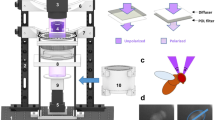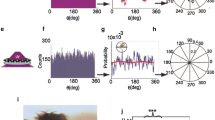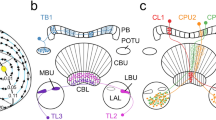Summary
InDrosophila polarization sensitivity as revealed in optomotor experiments is mediated by retinula cells R1–6.
In the optomotor turning response of the walking fly the response amplitude is a sinusoidal function of E-vector orientation of the stimulus light. For the effect to occur the area of the visual field in which moving vertical stripes are presented must be embedded in an illuminated surround which covers a large part of the visual field. The phase and amplitude of this sinus function do not reflect directly the polarization sensitivity of the photoreceptors mediating it since a) the amplitude is much larger than could be expected from the measured properties of fly retinula cells, b) the effect can be elicited in parts of the visual field viewed by photoreceptors of which half are oriented in mirror symmetry to the other half (equator, frontal area), c) presentation of the stimulus to either eye (at the same height) does not lead to a phase shift in the sinus functions. (A phase shift of 90 ° would be expected in our experiments if the response reflected the fly's bilateral symmetry.) The data suggest that the fly has an “inner” representation of E-vector orientation.
In a closed loop situation in which the fly is illuminated from above by linearly polarized light and is allowed to turn the orientation of the E-vector plane relative to its body axis by its yaw torque it can maintain its optomotor balance (i.e. it can fly straight). Often flies keep their longitudinal body axis roughly parallel or perpendicular to the E-vector plane during the whole experiment (4 min). Flies perform discrete 360 °-loops although the rotating polarizing filter has a 180 ° period. Viewed in the context of the first experiment this observation suggests that the fly, like the bee, evaluates the polarization pattern as a whole and designs its loons accordingly.
At least on clear daysDrosophila can make use of the polarization pattern of the free sky in flight orientation. Polarization sensitivity is not restricted to the upper part of the eye: Also with the lower part the fly can use a polarization pattern for course control.
Similar content being viewed by others
Abbreviations
- PDA :
-
prolonged depolarizing afterpotential
References
Braitenberg, V.: Patterns of projection in the visual system of the fly.I. Retina-laminaprojections. Exp. Brain Res.3, 271–298 (1967)
Buchner, E.: Elementary movement detectors in an insect visual system. Biol. Cybern.24, 85–101 (1976)
Cajal, S.R., Sanchez, D.: Contribución al conocimiento de los centros nerviosos de los insectos. Tab. Lab. Invest. Biol. (Madrid)13, 1–164 (1915)
Campos-Ortega, J.A., Jürgens, G., Hofbauer, A.: Cell clones and pattern formation: Studies onsevenless, a mutant ofDrosophila melanogaster. Wilhelm Roux' Arch. Entwicklungsmech. Org.186, 27–50 (1979)
Cosens, D.J., Briscoe, D.: A switch phenomenon in the compound eye of the white-eyed mutant ofDrosophila melanogaster. J. Insect Physiol.18, 627–632 (1972)
Fernandez-Morán, H.: Fine structure of insect retinula as revealed by electron microscopy. Nature (London)177, 742–743 (1956)
Frisch, K. von: Tanzsprache und Orientierung der Bienen. Berlin, Heidelberg, New York: Springer 1965
Götz, K.G.: Optomotorische Untersuchungen des visuellen Systems einiger Augenmutanten der FruchtfliegeDrosophila. Kybernetik2, 77–92 (1964)
Hauser-Holschuh, H.: Vergleichende quantitative Untersuchungen an den Sehganglien der FliegenMusca domestica undDrosophila melanogaster. Doctoral Thesis, Eberhard-Karls-Universität, Tübingen (1975)
Heisenberg, M.: Comparative behavioral studies on two visual mutants ofDrosophila. J. Comp. Physiol.80, 119–136 (1972)
Heisenberg, M., Buchner, E.: The rôle of retinula cell types in visual behavior ofDrosophila melanogaster. J. Comp. Physiol.117, 127–162 (1977)
Heisenberg, M., Wolf, R.: On the fine structure of yaw torque in visual flight orientation ofDrosophila melanogaster. J. Comp. Physiol.130, 113–130 (1979)
Hengstenberg, R., Götz, K.G.: Der Einfluß des Schirmpigmentge-halts auf die Helligkeits- und Kontrastwahrnehmungen beiDrosophila-Augenmutanten. Kybernetik3, 276–285 (1967)
Järvilehto, M., Moring, J.: Spectral and polarization sensitivity of identified retinal cells of the fly. In: Neural principles in vision. Zeltler. F., Weiler, R. (eds.), pp. 214–226. Berlin, Heidelberg, New York: Springer 1976
Kirschfeld, K.: Die Projektion der optischen Umwelt auf das Raster der Rhabdomere im Komplexauge vonMusca. Exp. Brain Res.3, 248–270 (1967)
Kirschfeld, K.: Aufnahme und Verarbeitung optischer Daten im Komplexauge von Insekten. Naturwissenschaften58, 201–209 (1971)
Kirschfeld, K.: Die notwendige Anzahl von Rezeptoren zur Bestimmung der Richtung des elektrischen Vektors linear polarisierten Lichtes. Z. Naturforsch., Teil B27, 578–579 (1972)
Kirschfeld, K.: Das neurale Superpositionsauge. Fortschr. Zool.21, 229–257 (1973a)
Kirschfeld, K.: Optomotorische Reaktionen der Biene auf bewegte “Polarisations-Muster”. Z. Naturforsch., Teil C28, 329–338 (1973b)
Kirschfeld, K.: The function of photostable pigments in fly photoreceptors. Biophys. Struct. Mechan.5, 117–128 (1979)
Kirschfeld, K., Franceschini, N.: Optische Eigenschaften der Ommatidien im Komplexauge vonMusca. Kybernetik5, 47–52 (1968)
Kirschfeld, K., Reichardt, W.: Optomotorische Versuche anMusca mit linear polarisiertem Licht. Z. Naturforsch., Teil B25, 228 (1970)
Kirschfeld, K., Franceschini, N., Minke, B.: Evidence for a sensitizing pigment in fly photoreceptors. Nature (London)269, 386–390 (1977)
Kirschfeld, K., Feiler, R., Franceschini, N.: A photostable pigment within the rhabdomere of fly photoreceptors No. 7. J. Comp. Physiol.125, 275–284 (1978)
Minke, B., Wu, C.F., Pak, W.L.: Isolation of light-induced response of the central retinula cells from the electroretinogram ofDrosphila. J. Comp. Physiol.98, 345–355 (1975)
Reichert, H., Bicker, G.: A visual learning study of brightness perception in two visual mutants ofDrosophila melanogaster. J. Comp. Physiol.133, 283–290 (1979)
Ribi, W.: Gap junctions coupling photoreceptor axons in the first optic ganglion of the fly. Cell Tissue Res.195, 299–308 (1978)
Schmidt, B.: Die neuronale Organisation in den Ocellen vonDrosophila. Thesis, Freiburg (1975)
Stark, W.S.: Spectral sensitivity of visual response alterations mediated by interconversions of native and intermediate photopigments inDrosophila. J. Comp. Physiol.96, 343–356 (1975)
Stephens, G.C., Fingerman, M., Brown, F.A.: The orientation ofDrosophila to plane polarized light. Ann. Entomol. Soc. Am.46, 75–83 (1953)
Strausfeld, N., Campos-Ortega, J.A.: L3, the 3rd 2nd order neuron of the 1st visual ganglion in the “neuronal superposition” eye ofMusca domestica. Z. Zellforsch. Mikrosk. Anat.139, 397–403 (1973)
Trujillo-Cenóz, O.: Some aspects of the structural organization of the intermediate retina of dipterans. J. Ultrastruct. Res.13, 1–33 (1965)
Willmund, R.: Light induced modification of phototactic behaviour ofDrosophila melanogaster. II. Physiological aspects. J. Comp. Physiol.129, 35–41 (1979)
Author information
Authors and Affiliations
Additional information
We thank Dr. K. Kirschfeld, Dr. K.G. Götz, Dr. K.F. Fischbach, Dr. J. Blondeau und Dr. E. Buchner for valuable suggestions and critical comments on the manuscript. While improving the torque meter one of us (R. Wolf) enjoyed the hospitality and technical advice of the Max-Planck-Institut für Biologische Kybernetik, Tübingen, Germany. We are also indepted to Mrs. K. Schulze and in particular to Mrs. B. Bruch for typing the manuscript. This work was supported by a grant of the Deutsche Forschungsgemeinschaft to M.H.
Rights and permissions
About this article
Cite this article
Wolf, R., Gebhardt, B., Gademann, R. et al. Polarization sensitivity of course control inDrosophila melanogaster . J. Comp. Physiol. 139, 177–191 (1980). https://doi.org/10.1007/BF00657080
Accepted:
Issue Date:
DOI: https://doi.org/10.1007/BF00657080




